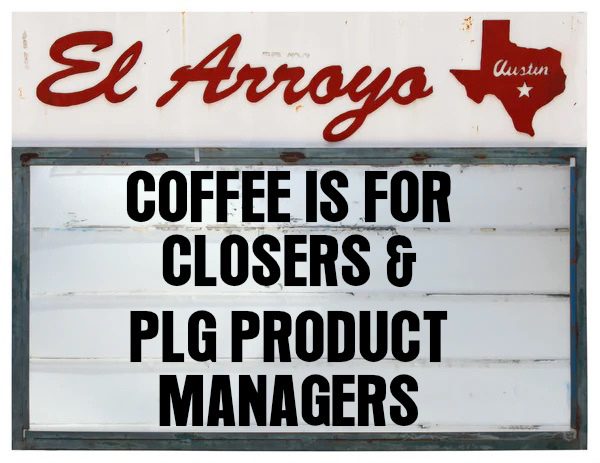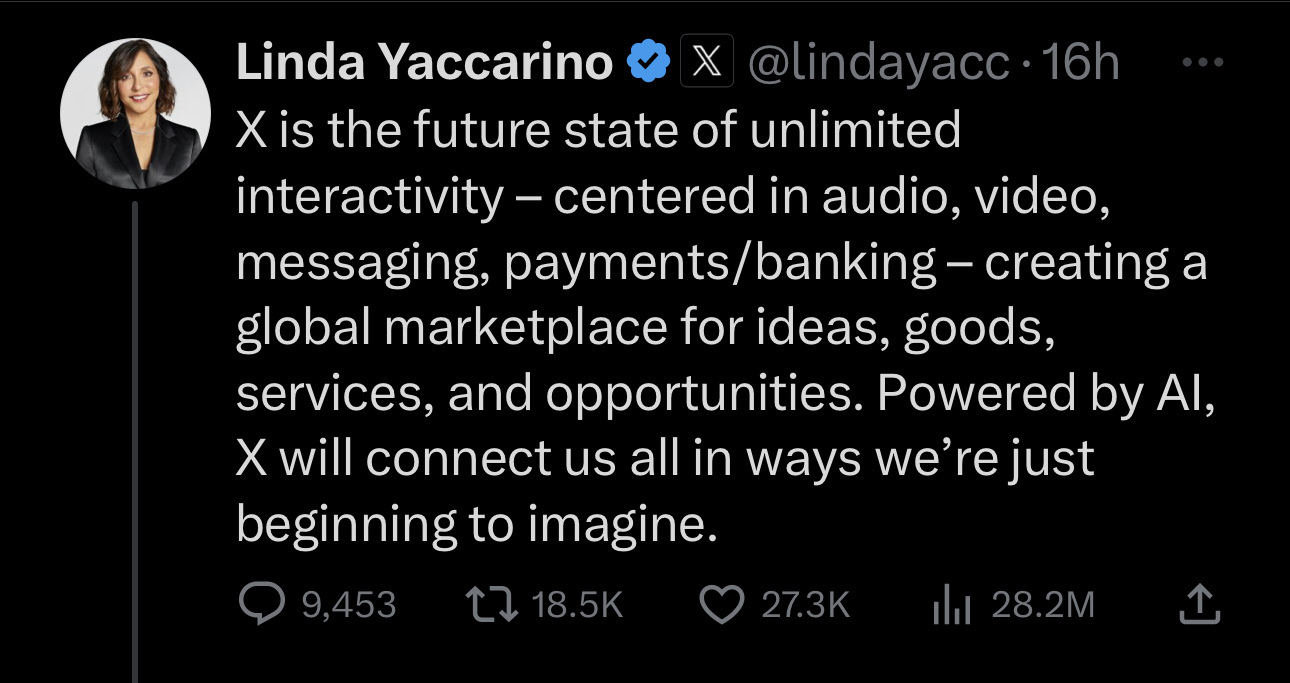The best product marketing teams need to drive three things:
- Help the product team build what sells.
- Help the sales team sell what we build.
- Help customers get the outcome we promised.
Product Marketing Fail
Just saw a product reposition themselves as:
“The all-in-one platform for businesses, Now with AI”
It may sound good in the echo chamber of your zoom meetings but this is literally meaningless to the potential customer.
It could also dismay your current customers, who might perceive that the app they love has now lost focus.

How to stop the hoarding of knowledge
Knowledge hoarding is the biggest problem in the workplace today. And it’s not always intentional on the employees part.
Building a culture of creating great documentation in the team wiki, Notion Confluence , or Tettra ( knowledge sharing ) starts at the top. If the CEO isn’t contributing and/or engaging with the knowledge the team is creating, the incentive for the leadership team to do the same is lessened. And that trickles down to the mid-level managers and individual co tributes too.
If you want to encourage a more collaborative workspace as a leader within your company, you have to lead by example and communicate that you expect your behavior to be an example.
Lead from the front. Not from behind the curtain.
Nostalgia is a powerful weapon.
It can stir emotions that change minds, sway opinions, even win elections…
Use it for good. Not evil.

Active listening
Active listening is such an important topic. I have tried to work on it and get better over time. I’m convinced it’s a skill everyone needs to get better at.
Especially in product management, where I’ve seen a lot of folks doing user research by leading the witness and looking for confirmation of what they believe.
Read this article by my friend, Pete Caputa to learn more. The article is aimed at sales folks, but applicable to everyone.
The “break-up email” in this SDR sequence is sure to at least get some replies. But I’m not sure it works as they intended.
It would be much better as the first message to get the back and forth going.
Relationships FIRST, business second.

Product-led vs. Sales-led isn’t a mutually exclusive choice. See this example from Toggl, who understands that different buyers have different needs. They signal that if you want to engage sales, you need to be considering the teams version (with 10+ seats). This page is very well executed.

Problem Marketing > Product Marketing
People don’t wake up in the morning excited to buy tools. They wake up in the morning excited to solve problems.
Sales-Led or Product-Led? Why not both?

Looking to start a @shopify eCommerce store after being out of the game for several years.
My thought is that it should serve a specific audience with curated products for multi-faceted lives, not a just be category of products.
Pros, where do you look for inventory? Do you drop ship or keep stock?
Do as I say, not as I do.
Do as I say, not as I do. 🚴 🪖 👨👩👧👦
Every day I ride my bike along the Trinity River in Fort Worth, TX.
Every day I see inevitably see a family out riding together where the child has a helmet on, but the parent(s) are riding without helmets.
What kind of message does this send for the children?
- Helmets are something that you can outgrow.
- Helmets aren’t cool.
- Helmets are good for you, but I (the parent) am too special for them.
How does this example show up in the workplace? Have you worked with people or managers that have the exact same mentality?
True leaders are out there setting the example by picking up random trash, showing up on time, being considerate of others, exhibiting the behaviors they want to see in their team.
They are wearing the helmets so their team knows what is important. They are showing true #leadership.
This is especially true in #productmarketing. There needs to be a shared vision, mission, values to keep everyone aligned, agile, and focused on building and selling the right product.
P.S. Helmets are cool.
The best reps KNOW THEIR CUSTOMERS. Those reps? Restaurant servers who bring the kid’s meals out ASAP and drop the check with the meal. How can we learn from these geniuses?
Product marketing is about giving your customers a clear story and the words to use to describe your product. How are we feeling about this clarity?

70mm

Prediction: the frontier of the web is “Identity”.
Twitter used to be a de facto standard for ones online identity.
They blew it.
The next big battle and opportunity for value creation will be how and where I am able to prove that I am who I am.
The implications are enormous.
Some good ideas here for replicating the impromptu real-time mentoring missing from distributed workforces.
Is Forcing Employees Back to the Office Wise?

A Company’s Single Store of Knowledge
The best thing a product marketing team can do for a sales team is give them ONE PLACE TO LOOK & SEARCH for the things they need. When you have a single source of truth, things become so much easier, and it’s easier to fill in the gaps.
Bonus thought: Ideally, each page would have a comment section so you can gauge the vailidity and helpfulness of each document. This is why good wiki software is such a good solution, but it has to be adopted across the WHOLE team.
I’ve led a few crosss-company projects to consolidate knowledge into one wiki, and its not easy; but the reward is there if you stick with it.
On buying software:
I’ve been on so many calls with robot SDR’s who probably mean well but their incentives don’t allow them to have human conversations.
It’s Beep. BANT. Boop. MEDDPICC.
Sales leaders need to do better for their teams.
Copywriting and StoryTelling
I found my love of copywriting and storytelling way back when I worked in an eBay store making $6.50 per hour. It’s my view that if you can write great copy and tell a great story, you can change the world.
In that eBay store, I would help to sell things on other’s behalf. It was my job to maximize the value of the product. Rather than just pasting product descriptions and generic specs, I learned that I had to write compelling headlines & hooks, and lead people toward a click. I had to learn what drew the people to the products in the first place. I had to weave that story into the product description.
Copy is at the very heart of every eBay listing, sales pitch, great investor deck, and every story. There are people who can write copy, but cannot tell a story. I have been told that one of my greatest strengths as the ability to combine those skills and create a narrative that helps companies grow. This growth does not come in a vacuum inside the marketing department. Great narratives combine great copywriting and great storytelling, but can be told by anyone in the organization.
Across every department, from the most strategic account executive, to the bookkeeper, to the summer intern; everyone needs to be able to use the same words to describe what the company is trying to do.
This is critical for a variety of reasons. One, if we expect our customers to understand what we do, we need to be very clear about giving them the words to use. I believe the product marketing job is to give customers the words to use in order to refer people that they know in our direction. If that is the north star, it guides everything we do.
Simplicity in message, simplicity in outcomes we deliver, simplicity on creating product launches that connect to the company vision.
These are all outcomes from creating a compelling company narrative based on copy writing and storytelling.
Too many companies launch features with a big splashy day, but they fail to follow up and use their product innovation to drive expansion in new customers.
This is typically because many features are launched and are never followed up on again. That’s a customer marketing problem.
Another reason this happens is that sales reps are not given the story that connects that new feature or product back to the company story.
I love helping people tell company stories. I love helping to create, package, and launch products the connect back to that company story. I believe that every feature that the company builds should be able to be tied back to that company’s vision through the company story. This makes it easier for customers to understand what we are building, but also makes it easier for sales reps to communicate the value of any new feature launch.
(I recently posted about this in a post called “The Product Marketing Ladder”, and am expanding on the process in future posts.)
To fail to give reps this connective issue is marketing malpractice.
How to Craft Better ChatGPT Prompts
I was asked a question on LinkedIn about how to craft better prompts for ChatGPT.
There are A LOT of thread people on Twitter sharing nonsense tips. It’s hard to find the signal in the noise. But… I have learned a few things that have helped me.
Most people ask it a question, ask it to produce an answer, or ask it to compose content. That’s fine. But they miss the most important thing, The System.
What is the “System”?
The System is the part of the prompt that tells the robot what it is, what it’s goals are, how to think about its response, and how to phrase it.
It’s one part of the puzzle that becomes clear when you log into the OpenAI Playground.
The other part of a prompt is “The Message”. That’s what most people type right in and expect greatness. Most of the prompts people share are just the message part.
Without the setup of the “System”, a “Message” doesn’t provide the background or guardrails needed to influence the voice and tone, or areas of known knowledge to pull from. The system is also great place to provide specifics around the format of the type answers that you want.
Check out this library for some inspiration on system prompts to pair with your “message” requests and it’ll immediately level up your game. I’ll try to post more about this soon and include some examples.